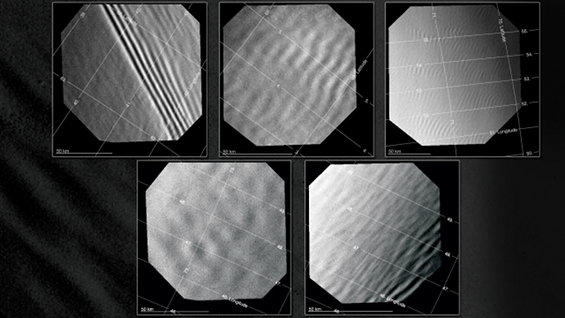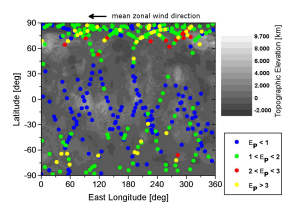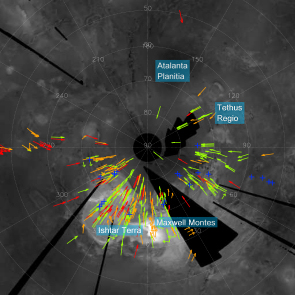Venus mountains create wave trains
13 January 2014
The planet Venus is blanketed by high-level clouds. At visible wavelengths, individual cloud features are difficult to see, but observations made by instruments on ESA's Venus Express orbiter have revealed many small-scale wave trains. Analysis shows that the waves are mostly found at high northern latitudes, particularly above Ishtar Terra, a continent-sized region that includes the highest mountains on the planet.
 |
| Wave trains on Venus. Credit: ESA/Venus Express/VMC/A. Piccialli et al., 2014. |
Venus is a world of contrasts. On the surface, the temperature reaches 450°C (723.15 K), hot enough to melt lead, while winds in the dense atmosphere blow at a sluggish 3-4 km/h. At the cloud tops, temperatures are a frigid -70°C (203.15 K), but wind speeds reach 300-400 km/h, much faster than hurricanes on Earth.
It might be expected, therefore, that there is little connection between the baking atmosphere close to the ground and the upper atmosphere, some 60-70 km above. However, spacecraft observations over several decades indicate that the relationship more resembles an 'ocean-like' lower atmosphere, topped by an opaque cloud layer which acts like the surface of the ocean. Ripples and air currents visible at the cloud tops provide hints about processes and influences far below.
Early evidence of atmospheric waves being generated by air flowing over major topographic features came in 1985, when two Soviet Vega balloons flying at an altitude of 54 km experienced a bumpy ride above the southern uplands of Aphrodite Terra.
Almost three decades later, observations made by instruments on board Venus Express provide new evidence that confirms the upward propagation of atmospheric waves from the surface to the main cloud deck and above.
These so-called gravity waves can only exist in a stably stratified atmosphere. They can be triggered, for example, by convection (the rise of lighter, warmer air) from below or by horizontal flow passing over an obstacle, such as a mountain. This is the same process that creates ripples on the surface of a river when it flows over a submerged boulder.
Gravity waves are very important since they can transport energy and momentum by propagating both vertically and horizontally through the atmosphere. They are a common feature in the upper atmospheres of terrestrial planets. On Earth, gravity waves frequently reveal their presence through cloud formations, such as in the case of waves on the lee side of mountains. They often take the form of wave trains - a series of waves travelling in the same direction and spaced at regular intervals.
 |
| Gravity waves detected with VeRa. Credit: ESA/Venus Express/VeRa/S. Tellmann et al., 2012 |
Evidence for this wave formation process in the atmosphere of Venus was first reported in November 2012, when an international team, led by Silvia Tellmann of the Rheinisches Institut für Umweltforschung, University of Cologne, Germany, used the Venus Express Radio Science Experiment (VeRa) to obtain atmospheric profiles above the planet's limb at altitudes of 40-90 km.
By studying changes in the frequencies of the radio signals as they were reflected and bent during their passage through the Venus atmosphere en route to Earth, the team obtained more than 500 atmospheric profiles between the spacecraft's arrival at Venus in 2006 and July 2011. The data enabled them to calculate pressure and temperature at different altitudes and locations above the planet.
These side views of the upper atmosphere made it possible to study the dependence of small-scale, vertical temperature variations on local time and latitude. Temperature differences of a few degrees Celsius and vertical wavelengths of 1-4 km were extracted from the data, revealing numerous gravity waves. These were evident as quasi-periodic disturbances on the atmospheric temperature profiles, often hundreds of kilometres across.
The waves were found to be more common at latitudes 60-75 degrees, with the greatest activity on the lee side of mountains in the northern hemisphere.
"We believe that these waves are at least partly associated with atmospheric flow over Ishtar Terra, an upland region which includes the highest mountains on Venus," said Silvia Tellmann. "We don't yet fully understand how such topographic forcing can extend to high levels, but it seems likely to be one of the key processes for the generation of gravity waves at high northern latitudes on Venus. The waves may form when a stable air flow passes over the mountains."
This result has now been confirmed by a separate analysis of waves seen at the cloud tops of Venus in images taken by the Visible Monitoring Camera (VMC) on Venus Express. The new study, published in the January 2014 issue of Icarus, was carried out by an international team led by Arianna Piccialli, a postdoctoral research fellow at the Laboratoire Atmospheres, Milieux, Observations Spatiales (LATMOS-UVSQ), Guyancourt, France. She was based at ESA's ESTEC facility in the Netherlands when the research was undertaken.
High resolution images of Venus' northern hemisphere obtained with the VMC during more than 1500 orbits made it possible to conduct for the first time a detailed study of small-scale features at the cloud tops, 62-70 km above the surface. A systematic visual search in the images was undertaken, and wave patterns were observed in more than 300 images.
 |
| Distribution of different wave types on Venus. Credit: ESA/Venus Express/VMC/A. Piccialli et al., 2014 |
Four types of waves - long, medium, short and irregular - were identified in VMC images, based on their size and shape. Long waves appeared as narrow straight features extending more than a few hundreds of kilometres and with wavelengths (separation of crests) between 7 and 17 km. Medium type waves exhibited irregular wave fronts extending for more than 100 km and with wavelengths of 8 - 21 km. Short waves had a width of several tens of kilometres and extended to a few hundreds of kilometres, with wavelengths of 3 -16 km. Irregular wave fields appeared to be the result of wave interference.
The waves were often identified in images taken at several different wavelengths (ultraviolet – 365 nm; visible – 513 nm; and near-infrared – 965 nm and 1000 nm). As was the case with the waves detected by VeRa, they were mostly found at high latitudes (60-80 degrees N) in a region of high cloud known as 'the cold collar', and they were concentrated above the continent-sized highland of Ishtar Terra.
"The elliptical orbit of Venus Express, with pericentre (nearest point to the planet) above northern high latitudes, meant that we could obtain images with a spatial resolution of a few hundreds of metres per pixel in this region," said Arianna Piccialli.
"Unfortunately, this only enabled us to obtain small snapshots of cloud features. Furthermore, the high speed (9 km/s) of the spacecraft close to pericentre did not allow us to measure the speed of the waves, due to the short time interval between image pairs.
"By themselves, these constraints do not allow us to establish with absolute confidence the nature of these waves. However, by comparing the morphology and properties of the wave features observed in VMC images to those seen by previous observations – such as the VeRa data - it is reasonable to assume that the waves studied here are gravity waves associated with air flow over the uplands of Ishtar Terra."
"This is an exciting result because it strengthens the case that topography is likely to be a significant influence on the atmospheric circulation of Venus," said Håkan Svedhem, ESA's project scientist for Venus Express.
"This influence has been predicted by models but never observed in such detail until now. Understanding the mechanisms of surface influence on atmospheric processes is crucial for understanding the maintenance of the remarkably rapid circulation of the atmosphere at Venus' cloud tops.
"Such results show the versatility of Venus Express, which has made it possible to study the same phenomenon by using two independent and quite different techniques - imaging and radio occultation. It also confirms, once again, that ESA satellites are providing data of crucial importance for understanding our planetary neighbours."
Background Information
The results described in this article are reported in High latitude gravity waves at the Venus cloud tops as observed by the Venus Monitoring Camera on board Venus Express, by Arianna Piccialli et al., published in Icarus, 227, 94-111, 2014; doi:10.1016/j.icarus.2013.09.012; and Small-scale temperature fluctuations seen by the VeRa Radio Science Experiment on Venus Express, by Silvia Tellmann et al., published in Icarus, 221, 471-480, 2012; doi:10.1016/j.icarus.2012.08.023.
Venus Express is Europe's first mission to Venus. It was launched from Baikonur Cosmodrome on 9 November 2005 on a Soyuz-Fregat launcher, and was inserted into Venus orbit on 11 April 2006. Venus Express orbits the planet in a 24 h period polar orbit. Its payload includes a combination of spectrometers, spectro-imagers, and imagers covering a wavelength range from ultraviolet to thermal infrared, a plasma analyser and a magnetometer.
The Venus Monitoring Camera (VMC; principal investigator W. Markiewicz, MPI-Ae, Katlenburg-Lindau, Germany) is a wide-angle multi-channel camera that takes images in the near infrared, ultraviolet and visible wavelengths. The Venus Express Radio Science Experiment (VeRa; principal investigator B. Häusler, Universität der Bundeswehr, München, Germany) uses the powerful radio link between the spacecraft and Earth to investigate the conditions prevalent in the ionosphere and atmosphere of Venus.
Contacts
Silvia Tellmann
Rheinisches Institut für Umweltforschung (RIU)
Department of Planetary Research at the University of Cologne, Germany
Phone: +49-221-277-81-813
Email: stellman![]() uni-koeln.de
uni-koeln.de
Arianna Piccialli
Laboratoire Atmosphères, Milieux, Observations Spatiales (LATMOS)
Guyancourt, France
Phone: +33-1-80-28-51-30
Email: arianna.piccialli![]() latmos.ipsl.fr
latmos.ipsl.fr
Håkan Svedhem
Venus Express project scientist
Directorate of Science & Robotic Exploration
European Space Agency
Phone: +31-71-565-3370
Email: hakan.svedhem![]() esa.int
esa.int



